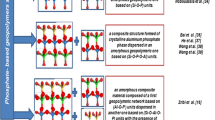Abstract
Spectacular technological progress has been made in the last few years through the development of new materials such as ‘geopolymers’, and new techniques, such as ‘sol-gel’. New state-of-the-art materials designed with the help of geopolymerisation reactions are opening up new applications and procedures and transforming ideas that have been taken for granted in inorganic chemistry. High temperature techniques are no longer necessary to obtain materials which are ceramiclike in their structures and properties. These materials can polycondense just like organic polymers, at temperatures lower than 100 deg. C. This new generation of materials, whether used pure, with fillers or reinforced, is already finding applications in all fields of industry. Some examples:
-
pure: for storing toxic chemical or radioactive waste, etc.
-
filled: for the manufacture of special concretes, molds for molding thermoplastics, etc.
-
reinforced: for the manufacture of molds, tooling, in aluminum alloy foundries and metallurgy, etc.
These applications are to be found in the automobile and aerospace industries, non-ferrous foundries and metallurgy, civil engineering, plastics industries, etc.
Zusammenfassung
Durch die Entwicklung von solchen neuen Materialien wie “Geopolymere” und neuen Verfahren wie “Sol-Gel” kam es in den letzten paar Jahren zu einem bedeutenden Fortschritt in der Technologie. Neue, mittels Geopolymerisationsreaktionen dargestellte Avantgarde-Materialien öffnen den Weg zu neuen Anwendungen, Verfahren und zur Umsetzung von Ideen, die in der anorganischen Chemie für selbstverständlich angenommen wurden. Zur Herstellung von in Struktur und Eigenschaften keramikähnlichen Stoffen sind keine Hochtemperaturverfahren mehr notwendig. Diese Materialien können wie organische Polymere bei Temperaturen unter 100°C polykondensieren. Diese neue Generation von Materialien hat — rein, mit Füllern oder faserverstärkt angewendet — ihren Anwendungsbereich auf allen Gebieten der Industrie schon gefunden:
-
rein: zur Endlagerung von toxischen, chemischen und radioaktiven Abfallstoffen usw.
-
mit Füllern: zur Herstellung von Spezialbetons und Formen zur Gestaltung von Thermoplasten usw.
-
faserverstärkt: zur Herstellung von Formen und Werkzeugen für die Giesserei und in der Metallurgie der Aluminiumlegierungen usw.
Diese Anwendungen können in der Automobil-, Luftfahrtindustrie, in der Nichteisenmetallurgie, im Baugewerbe, in der Kunststoffindustrie usw. angetroffen werden.
Резюме
Представлены принци пы эманационного термического анализ а, основанного на измер ении инертного газа, выделяющегося из твердых тел. Предст авлены результаты компьютерного модел ирования кривых выделения ине ртного газа при нагревании пористых и дисперсных образцо в. С помощью эманацион ного термического анализа проведена ха рактеристика высоко-технологичны х керамических материалов и исходно го для них сырья, заключающаяся в определении реакци онной способности и с пекаемости керамических порошков, качественн ой проверке промежут очных и конечных продуктов получаемы х высоко-технологичн ых материалов/ферритов, окиси тория, окиси ура на, сверхпроводящей оксидной керамики и др/.
Similar content being viewed by others
References
J. Davidovits, Transfer and Exploitation of Scientific and Technical Information. EUR 7716, Commission of the European Communities Luxembourg, (1982), p. 316.
R.M. Barrer, Trans. Brit. Ceramic. Soc., 56 (1957), 155.
D.W. Breck, Zeolite Molecular Sieves, J. Wiley & Son ed., New York, (1974).
J. Davidovits, SPE PACTEC '79, Society of Plastic Engineers, Brookfield Center, USA, (1979) 151.
J. Davidovits, Concrete International: Design & Construction, 9 N∘12 (1987) 23.
R. Weiss, Chemische Rundschau, 39, Nov. 21 (1986), 1.
P. Moch, P. Thebaut, L. Girardot, M. Davidovics, Geopolymer '88, paper n∘ 10, Université de Technology Compiègne, France (1988).
J. Orlinski, Geopolymer '88, paper n∘ 9, Université de Technologie Compiègne, France (1988).
M. Guigon et J.L. Meyer, Geopolymer '88, paper n∘ 16, Université de Technologie Compiègne, France (1988).
J. Davidovits, Geopolymer '88, paper n∘ 2, Université de Technologie Compiègne, France (1988); see also Proceedings of Geopolymer '88, Vol.1, Geopolymer Chemistry.
C. Boutterin and J. Davidovits, Proceedings 22nd Symposium on Archaeometry, University of Bradford, U.K., (1982), 213. See also French Patent 2.490.626 (1982).
Report (unpublished) CANMET Canada, DSS Contract N∘ 23440-6-9195/01SQ, Preliminary examination of the potential of geopolymers for use in mine tailings management, (1987).
J. Davidovits, US Patent Application 104.190 (1987)
J. Davidovits and D. Comrie, Preprints Division Environ. Chemistry, Am. Chem. Soc., Toronto, (1988) 237.
J. Davidovits, SPE PACTEC '83, Society of Plastic Engineers, Brookfield Center, USA (1983) 222.
Report, Projet Matériaux 1982, P.0548, Ministère de la Recherche, Paris (1985).
N. Davidovits, M. Davidovics, J. Davidovits, Int. Patent Appl. PCT WO 88/02741 (1988).
J. Davidovits and M. Davidovics, ICCM & ECCM, Elsevier Applied Science, London, (1987) Vol.1, 462.
Ceramic Source '87, Am. Ceramic Soc., Colombus, Ohio, (1987) 251.
Author information
Authors and Affiliations
Rights and permissions
About this article
Cite this article
Davidovits, J. Geopolymers and geopolymeric materials. Journal of Thermal Analysis 35, 429–441 (1989). https://doi.org/10.1007/BF01904446
Issue Date:
DOI: https://doi.org/10.1007/BF01904446




